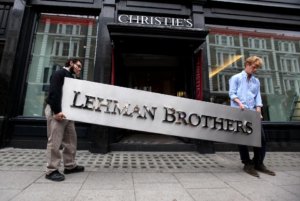This day in history: December 23, 2008 – Belly-up Lehman Brothers and the $700 million daily drop in FX volumes
“In the aftermath of the Lehman Brothers bankruptcy, FX volumes fell substantially, to almost as low as $3 trillion a day in April 2009, and did not return to the previous peak until the beginning of 2011. Thus, the drop coincided with the precipitous fall worldwide in financial and economic activity in late 2008 and early 2009” – Morten Bech, Bank for International Settlements

A crisp, cold and frosty winter morning in Central London.
I remember it well, as if it were yesterday. The global financial crisis had gripped most large metropolitan cities and as 2008 entered its final week, the full extent of the damage to the vast majority of business and private individuals globally was evident.
London, being the world’s most important financial center, was a visual display of what could best be described as ‘calm panic’ in that the gentleman’s society that encompasses the social and corporate daily life in the Square Mile and Canary Wharf was peppered with evidence of reaction to the complete collapse of many of the world’s largest financial institutions, ranging from massive redundancies to lines of small business owners outside retail bank branches, to the quick sale of assets whilst the famous and very proper stiff upper lip was maintained.
Unlike less productive and less refined parts of the world, the British commercial environment and its highly talented workforce maintained decorum and rebuilt their economy to such an extent that central London now represents the pinnacle of modernity, FinTech innovation and interbank electronic trading efficiency, its retail and institutional giants being an example to the world.
However, on that memorable day, exactly eight years ago, Canary Wharf was battling with a very large and significant casualty, that being the finalization of the dismantling of bankrupt Lehman Brothers.
The run-up to the complete stripping of assets which resembled vultures picking at the left over remnants of a sandwich wolfed down quickly at lunchtime by an overburdened trader was lengthy and very complex, involving over three months of wrangling across two continents, led by some of the most senior central bank officials and heads of publicly listed financial giants.
On Saturday, September 13, 2008, Timothy F. Geithner, then the president of the Federal Reserve Bank of New York, called a meeting on the future of Lehman Brothers, which included the possibility of an emergency liquidation of its assets.
Lehman Brothers reported that it had been in talks with Bank of America and Barclays for the company’s possible sale, however, both Barclays and Bank of America ultimately declined to purchase the entire company, in the former case because the British government, in particular, the socialist Chancellor of the Exchequer Alastair Darling and the CEO of the Financial Services Authority Hector Sants, refused to allow the transaction at the last minute, quoting stockholder regulations in the UK, despite a deal having apparently been completed.
The next day, Sunday, September 14, the International Swaps and Derivatives Association (ISDA) offered an exceptional trading session to allow market participants to offset positions in various derivatives on the condition of a Lehman bankruptcy later that day. Although the bankruptcy filing missed the deadline, many dealers honored the trades they made in the special session.
Shortly before 1 am Monday morning Eastern Standard Time, Lehman Brothers Holdings announced it would file for Chapter 11 bankruptcy protection citing bank debt of $613 billion, $155 billion in bond debt, and assets worth $639 billion.
It further announced that its subsidiaries would continue to operate as normal.
A group of Wall Street firms agreed to provide capital and financial assistance for the bank’s orderly liquidation and the Federal Reserve, in turn, agreed to a swap of lower-quality assets in exchange for loans and other assistance from the government.
That particular morning, initial panic arose, this time internally, with Lehman employees removing files, items with the company logo, and other belongings from the world headquarters at 745 Seventh Avenue. The spectacle continued throughout the day and into the following day.
Later that day, the Australian Securities Exchange (ASX) suspended Lehman’s Australian subsidiary as a market participant after clearing-houses terminated contracts with the firm. Lehman shares tumbled over 90% on September 15, 2008.
The Dow Jones closed down just over 500 points on September 15, 2008, which was at the time the largest drop in a single day since the days following the attacks on September 11, 2001.
In the United Kingdom, the investment bank went into administration with PricewaterhouseCoopers appointed as administrators. In Japan, the Japanese branch, Lehman Brothers Japan Inc., and its holding company filed for civil reorganization on September 16, 2008, in Tokyo District Court. On September 17, 2008, the New York Stock Exchange delisted Lehman Brothers.
On September 29, 2008, Lehman agreed to sell Neuberger Berman, part of its investment management business, to a pair of private-equity firms, Bain Capital Partners and Hellman & Friedman, for $2.15 billion.
The transaction was expected to close in early 2009, subject to approval by the U.S. Bankruptcy Court, but a competing bid was entered by the firm’s management, who ultimately prevailed in a bankruptcy auction on December 23, 2008.
Creditors of Lehman Brothers Holdings Inc. retain a 49% common equity interest in the firm, now known as Neuberger Berman Group LLC. In Europe, the Quantitative Asset Management Business has been acquired back by its employees on November 13, 2008 and has been renamed back to TOBAM.
Barclays acquisition
On September 16, 2008, Barclays PLC announced that they would acquire a “stripped clean” portion of Lehman for $1.75 billion, including most of Lehman’s North America operations.
On September 20, 2008, a revised version of the deal, a $1.35 billion (£700 million) plan for Barclays to acquire the core business of Lehman (mainly its $960-million headquarters, a 38-story office building in Midtown Manhattan, with responsibility for 9,000 former employees), was approved.
Manhattan court bankruptcy Judge James Peck, after a 7-hour hearing, ruled:
“I have to approve this transaction because it is the only available transaction. Lehman Brothers became a victim, in effect the only true icon to fall in a tsunami that has befallen the credit markets. This is the most momentous bankruptcy hearing I’ve ever sat through. It can never be deemed precedent for future cases. It’s hard for me to imagine a similar emergency.”
Luc Despins, then a partner at Milbank, Tweed, Hadley & McCloy, the creditors committee counsel, said: “The reason we’re not objecting is really based on the lack of a viable alternative. We did not support the transaction because there had not been enough time to properly review it.”
At that time, Lehman’s attorney Harvey R. Miller of Weil, Gotshal & Manges, said “the purchase price for the real estate components of the deal would be $1.29 billion, including $960 million for Lehman’s New York headquarters and $330 million for two New Jersey data centers. Lehman’s original estimate valued its headquarters at $1.02 billion but an appraisal from CB Richard Ellis this week valued it at $900 million.”
Nomura acquisition
Nomura Holdings, Japan’s top brokerage firm, agreed to buy the Asian division of Lehman Brothers for $225 million and parts of the European division for a nominal fee of $2. It would not take on any trading assets or liabilities in the European units. Nomura negotiated such a low price because it acquired only Lehman’s employees in the regions, and not its stocks, bonds or other assets. The last Lehman Brothers Annual Report identified that these non-US subsidiaries of Lehman Brothers were responsible for over 50% of global revenue produced.
Sale of asset management businesses
On this day, December 23, 2008, a bankruptcy court held an auction which left creditors of Lehman Brothers Holdings Inc. retain a 49% common equity interest in the firm, now known as Neuberger Berman Group LLC.
The result of this commercial catastrophe was that in the period which ensued, the global FX volumes dropped substantially, as Lehman Brothers was an active institution in FX clearing and Tier 1 liquidity.
Morten Bech, a senior executive at the Bank for International Settlements took a close look at this in the immediately ensuring years.
“By using information from surveys conducted by FX committees around the world as well as settlement data from CLS Bank, I analyse how global FX market activity was affected by the recent financial crisis” said Mr Bech at the time.
“IMy research shows that FX activity continued to grow during the first year of the crisis but experienced a sharp drop after the Lehman bankruptcy, from which it recovered only slowly. I estimate that global FX activity was around $4.7 trillion a day on average in October 2011, compared with $4.0 trillion reported by the latest triennial central bank survey of foreign exchange activity conducted in April 2010.” – Morten Bech, Bank for International Settlements
Mr Bech stated that in the aftermath of the Lehman Brothers bankruptcy, activity fell substantially, to almost as low as $3 trillion a day in April 2009, and it did not return to its previous peak until the beginning of 2011. Thus, the drop coincided with the precipitous fall worldwide in financial and economic activity in late 2008 and early 2009. Global volumes had been over $4.7 trillion per day before the collapse of Lehman Brothers, and are now at approximately $5.8 trillion per day.
There has been a great deal of change in the interbank FX market this year, especially with regard to counterparty credit risk and Tier 1 banks which hold the largest share of FX dealing have begun to offload risky retail businesses and concentrate on institutional electronic trading even more than before. This is a good thing, however the very conservative attitude to risk, and the innovative methods that the OTC derivatives business has had to develop to work alongside these measures, are a testimony to the ingenuity of this fascinating and highly sophisticated industry’s capability.
For sure, we do not want another Lehman Brothers episode… Onwards and upwards in 2017!









